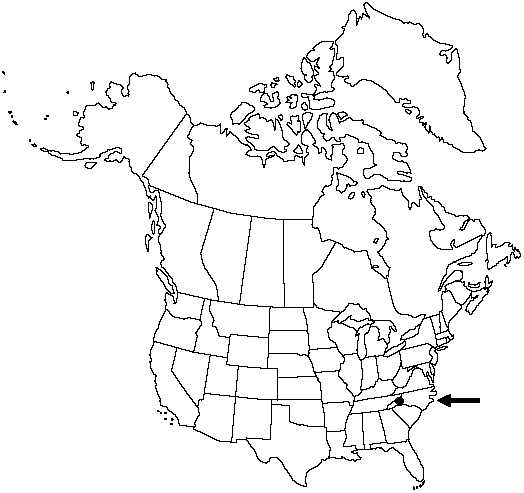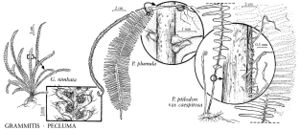Grammitis nimbata
Bull. Inst. Jamaica, Sci. Ser. 5: 34. 1953.
Stems erect, apices bearing scales; scales lustrous yellow to brownish, concolored, 0.5–1 mm, margins stiffly ciliate. Leaves densely fasciculate, 3–7 cm. Petiole 2–7 × 0.5 mm, densely hairy; hairs dark reddish or brownish, 0.8–1 mm. Blade linear, pinnatifid ca. 2/3 to rachis, narrowed and short-decurrent proximally, 3–5 mm wide; rachises and blade tissue on both sides with crowded, spreading setae like those of petiole or longer. Segments mostly in 20–30 pairs, oblique-spreading, oblong, 0.8–1.2 mm wide with entire margins. Veins concealed abaxially, unbranched, or fertile segments sometimes with single acroscopic branch, veins ending in hydathodes on adaxial surface. Sori round, 1 per segment, arising near base of acroscopic veinlet; sporangia glabrous.
Habitat: On moist cliffs behind falls
Elevation: ca. 500–1000 m
Distribution

N.C., West Indies in Cuba, Jamaica, Hispaniola
Discussion
Grammitis nimbata was discovered in the United States in Macon County, North Carolina, at a single locality, in 1966 (D. R. Farrar 1967) and has persisted to the present (D. R. Farrar, in litt. 1989). Primarily, the colony is gametophytic and reproduces by microscopic gemmae borne on the elongate-cordate thallus, but sterile sporophytes have been found in favorable years. The species description and illustration are based on mature spore-bearing plants from the Greater Antilles. The largest plants found from North Carolina are less than 3 cm.
Selected References
None.
